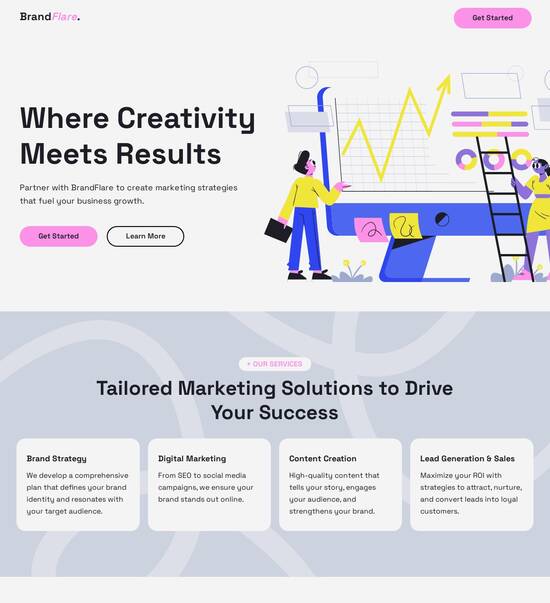
Awesome HTML page templates
Use TemplateAbout template
Master the art of web design with awesome HTML page templates. Transform your business today!
Recommended templates

Easy to build without coding
With the intuitive drag-and-drop builder, anyone on your team can create high-converting pages without any knowledge of code or design. Make enhancements to your landing page with custom widgets using Javascript, HTML/CSS, or third-party scripts.

Multiple layouts for any industry and goal
Select from 500+ landing page layouts built to boost conversions across industry-specific scenarios. Customize them by adjusting fonts, adding images, and generating on-brand content with the AI assistant. Quickly scale with Instablocks® and Global Blocks that you can save, reuse, and update globally.

Loads fast and looks polished on any device
Every template is responsive, which means they present professionally on any device and load blazingly fast with our Thor Render Engine. You can also power them up with Google AMP technology to deliver an unparalleled mobile experience and drive higher conversions.

Robust analytics & experimentation
Get real-time updates and reporting across all your devices, showing the number of visitors, conversions, cost-per-visitor, and cost-per-lead. Launch AI-powered experiments, run A/B tests, and use heatmaps to analyze user behavior, then optimize your landing page to maximize conversions.







Easy to build without coding
With the intuitive drag-and-drop builder, anyone on your team can create high-converting pages without any knowledge of code or design. Make enhancements to your landing page with custom widgets using Javascript, HTML/CSS, or third-party scripts.
Multiple layouts for any industry and goal
Select from 500+ landing page layouts built to boost conversions across industry-specific scenarios. Customize them by adjusting fonts, adding images, and generating on-brand content with the AI assistant. Quickly scale with Instablocks® and Global Blocks that you can save, reuse, and update globally.
Loads fast and looks polished on any device
Every template is responsive, which means they present professionally on any device and load blazingly fast with our Thor Render Engine.
Robust analytics & experimentation
Get real-time updates and reporting across all your devices, showing the number of visitors, conversions, cost-per-visitor, and cost-per-lead. Launch AI-powered experiments, run A/B tests, and use heatmaps to analyze user behavior, then optimize your landing page to maximize conversions.
All the features you need to build lead-generating landing pages
Explore more featuresLearn how to build top-performing landing pages for any goal
FAQs
Leading the way in building high-performing landing pages





A comprehensive guide to optimizing landing pages with Instapage
Optimizing landing pages is pivotal for maximizing conversions in any digital marketing strategy. Instapage empowers marketers with powerful tools and templates designed specifically for this task, enabling quick scalability and effectiveness in campaigns without the need for extensive coding or web development skills.
Understanding the importance of effective landing pages
Landing pages serve as critical touchpoints for visitors engaging with your marketing campaigns. A well-optimized landing page can significantly boost lead generation and conversion rates. Instapage offers over 100 high-converting templates tailored to various industries and user intents, providing the backbone for your marketing efforts.
- Conversion optimization: Instapage's templates are designed to guide visitors through the conversion funnel seamlessly.
- Lead generation tools: Integrated lead capture elements ensure you gather valuable information while enhancing user experience.
- Speed to market: Quickly launch high-quality landing pages without needing a development team, making campaigns agile.
Step 1: Choose the right template and elements
The first step in creating a successful landing page is selecting a template that aligns with your campaign goals. Here’s how to get started:
- Assess your audience: Understand what resonates with your target demographic by leveraging data insights into their preferences.
- Template selection: With Instapage’s diverse library, choose templates that reflect your brand identity while meeting the functional requirements of your campaign.
- Incorporate lead generation: Utilize forms, buttons, and CTAs crafted to entrap leads effectively and increase your conversion potential.
Step 2: Optimize for user engagement
Once your template is selected, optimizing for engagement is vital. Consider these key techniques:
- Dynamic text replacement: This feature allows personalization tailored to specific ad campaigns and user profiles, enhancing relevance.
- Add multimedia: Use videos and images strategically as they can significantly improve engagement by appealing to visual learners.
- Feedback loops: Use real-time analytics to see what is working and what isn't, enabling you to make data-driven adjustments quickly.
Step 3: Implement and test for conversion
Launching your landing page is just the beginning. It’s essential to monitor performance and optimize continually:
- A/B testing: Create variations of your landing pages and analyze performance using heatmaps and visitor analytics to see where improvements can be made.
- Feedback collection: Encourage user feedback post-conversion to gauge satisfaction and areas for enhancement.
- Analytics dashboard: Use Instapage's integrated analytics to gather insights on user behavior on your landing page.
Integrating these steps effectively creates a robust landing page that engages users while maximizing conversions.
Ready to elevate your digital marketing strategy? Start creating stunning landing pages with Instapage today and experience unprecedented growth.
People also ask about Awesome HTML page template
Awesome HTML page templates: A comprehensive guide
The evolution of HTML page templates
HTML templates have significantly influenced web design over the years. Initially, web pages were static, consisting mainly of simple HTML code that conveyed information without much visual excitement or interactivity. As the web matured, designers realized the potential of templates to enhance user experience and engagement. This led to the creation of more dynamic pages with interactive elements, laying the groundwork for what we now refer to as modern web design.
The evolution didn’t stop there. With the rise of content management systems and advanced frameworks, the transition from simple designs to complex ecosystems became evident. Today, an awesome HTML page template can encompass various elements, from interactive galleries to real-time data displays, creating a seamless experience for users.
The role of CSS in enhancing HTML templates
CSS plays a pivotal role in the aesthetics and functionality of HTML templates. By separating the content (HTML) from presentation (CSS), designers can create visually appealing interfaces while ensuring that the code remains clean and easy to maintain. The synergy between HTML and CSS is crucial as they work together to enhance user experience, making websites not only visually stunning but also easier to navigate.
Various CSS frameworks complement HTML templates, such as Bootstrap and Tailwind CSS, providing developers with pre-built styles and components that foster consistency and accelerate the design process. These frameworks also contribute to the overall functionality of HTML templates, allowing for robust design and seamless performance.
Exploring the features of an awesome HTML page template
An excellent HTML page template is characterized by its comprehensive layout options. Designers must understand the structure of their template, whether it's a single-page or multi-page format. Single-page templates are compact, offering a scrolling experience, while multi-page templates allow for a more extensive exploration of content. The decision ultimately hinges on the project's scope, with block templates providing better organization and content management.
Responsive design is a key feature that makes an HTML template truly awesome. With an increasing number of users accessing websites on mobile devices, it's imperative for templates to adapt to varying screen sizes. CSS media queries enhance this responsiveness, ensuring that content is accessible and visually appealing on any device. The emphasis on mobile-first design not only improves the user experience but also boosts search engine rankings.
Comprehensive layout options: Single-page and multi-page structures.
Responsive design with mobile-first principles.
Pre-built elements for streamlined design.
Pre-built elements for streamlined design
Beyond layout options, the presence of pre-built elements is a significant advantage of awesome HTML page templates. Common elements such as buttons, forms, and navigation bars enhance usability and visual consistency. These components can be customized easily, enabling developers to align the existing template with their unique branding needs. Customization is key, as it allows for alterations without starting from scratch, saving time and resources.
The intricacies of using a template editor
Navigating a template editor can significantly simplify the process of designing a website. An intuitive interface with user-friendly design tools allows designers to edit templates with ease. Most template editors present a visual interface that provides drag-and-drop capabilities, allowing users to rearrange elements without delving into code. This accessibility invites a broader audience to explore web design, from seasoned developers to those new to the space.
Integrating business needs into design is another critical aspect of utilizing template editors. Whether you’re building for e-commerce, portfolios, or business services, these platforms offer tailored templates with elements specific to various industries. Customization options enable businesses to align their web presence with their branding, ensuring a consistent identity across all platforms.
Versatility of HTML templates across different sectors
One of the most compelling attributes of HTML templates is their versatility across different sectors. For business websites, templates can strike a harmonious balance between professionalism and functionality. Features such as testimonials, portfolios, and service descriptions can be seamlessly integrated into corporate designs, fostering brand trust and consumer engagement. Businesses that have implemented these templates often report increased efficiency and conversion rates, directly attributable to a well-structured web presence.
Similarly, portfolio pages rely heavily on striking visuals and user-friendly navigation. Key elements like galleries, embedded videos, and case studies enhance visual storytelling, captivating prospective clients or employers. Examples of striking portfolio designs often highlight creativity while showcasing relevant work, demonstrating the effectiveness of good template design.
Business websites: Professional and functional.
Portfolio pages: Enhancing visual storytelling.
E-commerce: Optimizing for secure transactions.
HTML e-commerce templates revolutionize online shopping experiences by integrating essential features like product displays, secure payment gateways, and user reviews. The necessity for secure and efficient design cannot be overstated in the e-commerce space, where consumer trust is paramount. Well-implemented templates often function as a catalyst for increased sales, focusing on user-friendly experiences that encourage purchases.
Maximizing content potential with page templates
Strategic placement of content blocks is crucial in maximizing the potential of HTML page templates. The impact of layout on user engagement and conversions cannot be ignored; a clearly defined flow guides users through the content, making it easier for them to absorb information. Best practices dictate that the most important content should be positioned prominently, ensuring that users encounter it first.
Additionally, understanding on-page SEO elements is critical for enhancing visibility. Features like header tags, alt text for images, and well-structured URLs contribute significantly to SEO rankings, creating a necessary synergy between design and optimization. Leveraging these elements within templates allows developers to flourish in organic search visibility, maximizing the potential reach of their web presence.
Innovating with HTML themes
Differentiating between themes and templates is essential for developers seeking a comprehensive design ecosystem. Themes provide an overarching design framework that includes customizable templates, styles, and functionality, while templates function as building blocks within themes. This distinction allows designers to understand how to select or develop what best meets their design needs.
Finding the perfect balance between customization and pre-built options is vital for effective design. Customizable themes allow for flexibility in content management, ensuring that dynamic content accurately reflects branding needs while maintaining design consistency. The ability to tailor themes is critical for businesses aiming to create a strong online identity that resonates with their audience.
Creating a seamless user experience
The design of HTML templates plays a significant role in user retention. Psychological aspects of design—such as color, typography, and layout—affect user perceptions and interactions with the website. It’s essential for designers to consider these factors to create a visually cohesive experience that encourages return visits. Additionally, ensuring fast loading times and clean code contributes to overall user satisfaction.
However, accessibility should also remain a top priority in design. Templates must be developed to ensure usability for all demographics, including individuals with disabilities. Best practices for accessible web design involve incorporating features like alternative text for images and ensuring keyboard navigation functionality, emphasizing inclusivity alongside aesthetics.
Future trends in HTML template design
As web design continues to evolve, so too do HTML templates, notably influenced by emerging technologies. AI and machine learning can optimize design processes by providing insights into user behavior, allowing for improvements in template structures and features. Additionally, the rise of voice and augmented reality (AR) integration in web templates signifies the need for designers to stay ahead of the curve, adapting their templates to accommodate these technologies.
Sustainability considerations are increasingly relevant within web design, leading to eco-friendly practices in template development. By focusing on minimalism and efficiency, designers can create templates that not only perform well but also reduce resource consumption, appealing to environmentally conscious consumers.
Real-world applications and success stories
There are numerous case studies illustrating how businesses have transformed their web presence through well-designed templates. For example, a local e-commerce store improved its sales significantly by adopting a streamlined HTML template that allowed for quick navigation and easy product discovery. Such examples highlight the practical benefits of investing in quality templates.
User testimonials often reinforce the value of compelling templates. Personal stories share experiences of efficiency and growth, with before-and-after scenarios showcasing quantitative results. These narratives emphasize how a thoughtfully designed template can play a crucial role in achieving business goals.
Workshop: Crafting your own awesome HTML page template
To craft an amazing HTML page template, the first step is identifying your design goals. Consider the primary purpose of your website—whether it’s for business or personal use. Developing mood boards can help capture inspiration and align your design vision with audience expectations. This foundational step ensures that you build a template that resonates with your target demographic.
A hands-on guide to building with block templates involves practical tips for combining various components effectively. Focus on organizing content blocks in a way that maintains flow and maximizes engagement. Testing and iterating on your design is essential for optimal performance, ensuring that every element contributes positively to the user experience.
Ready to skyrocket conversions?
Supercharge your ad campaigns with high-performing landing pages
Get started














